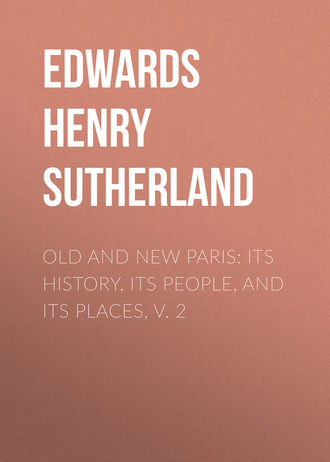 полная версия
полная версияOld and New Paris: Its History, Its People, and Its Places, v. 2
The royal suburb which Louis XIV. had created, which the Paris-loving Regent disdained, and which Louis XV. feared as associated with an attempt on his life, was destined to become the favourite residence of the homely, kindhearted Louis XVI. and Marie Antoinette, his charming wife; and Versailles has since been as closely associated with revolutions and with the disasters of France as formerly with the splendour and luxury of the monarchy at its supreme point of development. Versailles was the scene of the strange intrigues known collectively as “the affair of the necklace,” and it was at Versailles that the king and queen were openly threatened by the revolutionary mob.
The affair of the diamond necklace was turned to the disadvantage and grave injury of the queen by all her enemies, though it is certain that Marie Antoinette had nothing whatever to do with the matter. A certain Countess de Lamotte-Valois was the prime mover in the affair, and she acted throughout with an ingenuity which surprised the good faith of many. Born in a comparatively humble position, she became the wife of a dissipated and ruined count; when, determined to turn her newly acquired position to account, she went to Paris, where she succeeded in getting presented to Marie Antoinette and also to Cardinal de Rohan, the king’s grand almoner. She persuaded the cardinal, that to secure the eternal gratitude of the queen it was only necessary to obtain for her a necklace worth a million and a half francs which was in the possession of the court jewellers. De Rohan, moreover, was assured that the queen entertained for him the most tender affection, and, in order to carry conviction to the cardinal’s mind, a Mlle. d’Olivia, who much resembled Marie Antoinette, was induced to personate her at a midnight interview with His Eminence in the gardens of Versailles. Armed with the real signature of Cardinal de Rohan and a forged signature of the queen, the countess got possession of the necklace (February 2, 1786), which she forthwith carried to London and there sold it in fragments. Meanwhile, she pretended that she had delivered the necklace to Marie Antoinette, and she succeeded in concealing her robbery for several months by producing fictitious notes in handwriting imitated from that of Marie Antoinette. At last a direct application was made by the jewellers to the queen herself, which resulted in a public trial before the Parliament of Paris. The affair caused the greatest excitement throughout France. There was no evidence which really told against the queen, and all that could be urged against the cardinal was that his folly and fatuity had enabled the Countess de Lamotte to make him an easy dupe. De Rohan, then, was acquitted, while the countess was sentenced to be whipped, branded on the shoulder, and imprisoned for life. After two years confinement at the Salpêtrière, she escaped in June, 1787, and fled to London, where she published scandalous libels against the queen. In spite of her innocence, Marie Antoinette was suspected by the common people of having played the part attributed to her by the infamous Lamotte, and even when, five years later, she was being carried to the guillotine, sarcasms in reference to the affair of the necklace were hurled at the unfortunate woman by the mob.
That a queen should, in her wanton extravagance, have ordered a necklace worth some £60,000, and afterwards have neglected to pay for it, and thrown the odium of the transaction upon other persons, seemed natural enough to the embittered populace, driven wild by oppression and hunger, and the feeling caused by the Countess de Lamotte’s shameful calumnies against Marie Antoinette (the Revolution having meanwhile begun) had doubtless much to do with the menacing attitude of the crowd, who soon afterwards threatened both king and queen in their palace at Versailles.
The people of Paris entertained the gravest distrust of the king and queen. As the crisis was drawing near the queen entreated her husband to leave Versailles for Compiègne or Fontainebleau. She counted, above all things, on the Marquis de Bouillé, who commanded the troops on the eastern frontier, with headquarters at Metz. The Comte d’Estaing, commanding the National Guards at Versailles, was ready not only to aid the escape of the royal family, but, if necessary, to protect their flight; and the municipality of Versailles had empowered him to act freely against any movement made from Paris upon Versailles. It was essential to secure the co-operation of the king’s body-guard and of the Versailles garrison; and with this view the king, queen, and royal family assisted at a grand banquet given on the 1st of October by the king’s body-guard to the Regiment of Flanders in the theatre of the Palace. The population of Paris saw in these marks of goodwill towards the troops proofs of treachery. The excitement led to insurrection, and Versailles was invaded by the Parisian mob. On the 15th of October, at six in the morning, the tocsin was sounded in Paris. The National Guards quickly assembled, and a market-woman collected other market-women around her by beating a big drum. The women were animated less by political ideas than by a determination, by all possible means, to save their children from starvation. They had been told that there would be bread enough in Paris if the king and queen were there. Several volunteers belonging to the band which had played a leading part in taking the Bastille placed themselves at the head of the infuriated women and of the rabble who accompanied them. In the rear marched the conquerors of the Bastille in a body; not, it was said, to co-operate with the women, but, if necessary, to protect them. The municipality of Paris ordered General Lafayette to take measures in view of the threatened conflict; and, calling out the force distinctively known as the “paid battalion” – the former Gardes Françaises – he at the same time concentrated various volunteer battalions at different points. He delayed, however, ordering an advance until four o’clock in the afternoon. He wished, as Mr. Morse Stephens puts it, “to be the saviour of the king, and it would not be sufficiently glorious to forestall the danger.”
The news that a mob was marching on Versailles reached the king while he was hunting. Receiving the intelligence with his usual indifference, he nevertheless went back to the palace, where he found the body-guard, six hundred strong, and the Regiment of Flanders drawn up in order of battle. About two hundred of the National Guards at Versailles had taken up their position at some distance from the troops, but with no intention of assisting them. The women of Paris arrived between three and four o’clock in the afternoon. Some went at once to the palace and demanded food, which was readily given to them. Versailles had been made the meeting-place of the National Assembly, and the first French Parliament (not, of course, to be confounded with the judicial Parliament of Paris) was engaged in a debate when Maillard, representing the conquerors of the Bastille, entered the hall and demanded, on behalf of the women, that the price of bread should be lowered by a formal decree. The Assembly appointed a deputation of its own members to accompany a deputation of the women to the king. The deputations were most graciously received. But this only increased the difficulty; and on returning to their sisters, the women who had waited upon the king were furiously attacked for having condescended to such a step. Towards evening the royal travelling-carriages were seen issuing from the stables; and the cry at once arose that the king must not be allowed to escape. Several of the Versailles National Guards rushed forward and insisted on the carriages being driven back. An hour afterwards the body-guard, which was to have accompanied the king in his flight, retired to their barracks. As they did so they were fired upon by the National Guards of Versailles, and one of their horses was killed. It was immediately roasted and eaten by the Parisian mob.
At last, towards eleven o’clock, Lafayette arrived with the greater part of the National Guards of Paris, the paid battalion, and several guns. He at once sought an interview with the king, and after assuring him of his power and willingness to protect him, called upon him to accept the “Declaration of the Rights of Man.” The king complied, and Lafayette, thinking, or pretending to think, that peace had been secured at least for the night, retired to his hotel. About five o’clock the next morning a portion of the mob, after supping on horseflesh and washing down the unaccustomed food with plentiful libations, had got into the gardens of the palace, and, finding a back-door unguarded, forced their way towards the queen’s apartments, killing, as they did so, two of the body-guards who defended the ante-chamber and staircase. Two other body-guards, however, defended her bed-chamber until she had time to escape by a private staircase to the king’s own room. The noise of the fighting brought up the paid battalion of the Paris National Guard, who in a few minutes cleared the palace of its invaders; and at about seven o’clock Lafayette came upon the scene. He persuaded the king, queen, and royal family to appear on the balcony, where they were greeted with shouts, “Le roi à Paris!” and after a brief parley with the king, the popular general announced that the king had accepted unconditionally the Declaration of the Rights of Man, and that he would start that afternoon for the capital. “Maillard,” says Mr. Morse Stephens, “with a body of followers, including men carrying the heads of slaughtered body-guards, started off at once to take the good news to Paris, where he was warmly received by the municipality. At a little past one the royal carriages left Versailles, and late in the evening, escorted by Lafayette on his white horse, the Parisian National Guards and the mob, reached the capital. The royal family first went to the Hôtel de Ville, where they had to listen to an harangue from Bailly, and then went to the Tuileries, which had been so long unoccupied that there were not even sufficient beds to sleep in. Thus ended the memorable days of October 5 and 6, 1789, to the great glory of General Morpheus, as the royalists called him, and to the real destruction of monarchical power in France.”
The Assembly had originally taken up its quarters at Versailles in order to be free from all pressure on the part of the Paris population. It now debated under the eyes of the Parisians, who were able to influence its deliberations in more ways than one. The hall set apart for it at Versailles had presented some material inconveniences. It was so large that the speeches of members were sometimes inaudible; and another disadvantage (which surely might have been prevented) is said to have been that the immense size of the hall allowed strangers to enter, interrupt the debates, and occasionally even vote.
It was only by express order of the king, after he had taken up his residence at the Tuileries, that the National Assembly forsook Versailles for Paris; and it now established itself in the Manège, or Riding School, an oblong building some 240 feet in length by 60 feet in width, situated on the north side of the Tuileries Gardens, just where the Rue de Rivoli now joins the Rue Castiglione. When the necessary alterations had been completed, it was found that the new building was much better adapted for the debates than the immense hall at Versailles. Even at the Manège there was plenty of room; and the Assembly having magnanimously invited “the whole nation” to be present at the debates, the galleries were crowded all day by the people of Paris, and especially by women of all classes, who took the keenest delight in the proceedings, applauding or hissing as they thought fit. Fruit-sellers and newspaper-girls wandered about with discordant cries, so that the galleries resembled in many respects the gallery of a theatre.
The French deputies were not to assemble again at Versailles until after the disasters of 1870 and 1871, when, as during the first months of the Revolution, it was thought desirable to avoid immediate contact with the too-excitable Parisians.
CHAPTER XLVII.
VERSAILLES AND THE SIEGE OF PARIS
The Advance on Paris – Preparations for the Siege – General Trochu – The Francs-Tireurs – The SiegeVERSAILLES, originally a pleasure abode for the most powerful of the French monarchs, had at last become a place of entertainment and of public displays for the French people when, in 1870, after the defeat of Sedan, it acquired new importance from its occupation by the enemies of France.
After Sedan, the enemy hastened to Paris, well knowing that the occupation of this town, at once the head and the heart of France, would put an end to all resistance throughout the country. From the moment that intelligence was received of the German advance upon the capital, the new Government gave a fresh impulse to the works of defence commenced under the Regency; and gigantic efforts were necessary to arm the fortifications at such short notice. To defend the whole of the works around Paris a hundred thousand men were necessary.
But Paris could muster three or four hundred thousand National Guards, animated by the most ardent patriotism, invincible behind their ramparts, and of which a select portion could face the enemy’s fire with the intrepidity of old troops. It was they who went to guard the ninety-four bastions forming a continuous girdle round the city. Paris was in a bubbling ferment of patriotism; everyone, young or old, rich or poor, hastened to have his name inscribed and to ask for a rifle. Agitation reigned everywhere, yet without producing the least disorder. Already, on the 19th of August, a committee of defence for the fortifications had been formed, composed of distinguished military officers and statesmen; and under the direction of this committee between sixty and seventy thousand men were employed to organise the resistance on the ramparts, where everything was deficient. All the gates of Paris were isolated from their approaches by the prolongation of the moat, drawbridges being now utilised. Beyond the moat, obstacles of all kinds were heaped up to arrest the assailants – branches of trees, broken glass, planks bristling with nails, and so forth: useless and almost infantine precautions, considering the formidable means employed by the Germans to reduce Paris from a distance.
Within the city boundary all was movement, animation, fever. Gun-carriages were passing to and fro freighted with enormous cannon; other pieces of ordnance were lying in the interior of the bastions, awaiting their frames. On the parapets guns already mounted were established in hollows dug out for the purpose. Two million bags of earth were piled up, from behind which the defenders could fire in safety upon the foe.
In the forts the same activity, the same preparations might be observed. Six were occupied by the marines. As the French fleet could play only a very insignificant part in this war, these men, with their guns of long range, were summoned from the sea-ports; and they were destined to render their country splendid services in the capital. With marvellous rapidity they fitted their own forts with cannon and earthworks.
At the beginning of the war the artillery were terribly short of arms. By the regulations each bastion should have been provided with eleven pieces. At that time there were only three to reply to the Krupp guns of the foe. By way of reserve, Paris was habitually furnished with two parks of artillery, each consisting of 250 pieces: but not one piece remained, the whole supply having been sent eastward. The ammunition for the cannon was terribly limited, being only sufficient to afford the guns ten shots apiece. The lack of artillerymen was even more lamentable; in some forts the entire force consisted of a man in charge of the battery. Towards the middle of October, however, the numbers of the artillery were rapidly raised to 13,000 officers, under-officers, and soldiers, thanks to the patriotism of retired officers of the marines and of the Gardes Mobiles of the Seine, the Seine-et-Oise, the Drôme, the Rhone, the Loire Inférieure, and the Pas-de-Calais.
By this time, too, 2,140 cannon had been mounted at the city boundaries, and the inadequate supply of powder had been increased six-fold. The director of all this prodigious activity was the indefatigable Minister of Public Works, M. Dorian, whose services, moreover, in ensuring the water supply were altogether invaluable.
Whilst such enormous progress was being made with the works of defence, the enemy was the reverse of idle. Its columns, meeting no obstacle on their way, were rapidly marching towards Paris. The news of their approach redoubled the activity of the Parisians. Everywhere in the capital warehouses were improvised in which were heaped up waggon-loads of hay and straw, sacks of corn, and provisions of all kinds. The church of Notre Dame des Champs was turned into a forage-depot: in front of the École Militaire a large supply of mill-stones was placed, in view of grinding the corn. The streets were constantly traversed by immense herds of oxen and flocks of sheep, which were about to be stalled and penned on the exterior boulevards, in the open spaces, and even in the avenues of the Luxemburg. Everyone laid in as large a stock of provisions as his resources would allow: rice, vermicelli, macaroni, potatoes, hams, sugar, coffee, vanished in a twinkling from the grocers’ shops. Yet the purchasers knew better than to eat freely of their provisions. They could not tell how long the siege would last.
Meanwhile the Prussians advanced, the more rapidly from feeling confident that no force could bar their passage and from being familiarly acquainted with the country. High-roads, country lanes, the veriest footpaths, were known to them, for in their ranks, to quote the words of a French historian, “was that crowd of Germans who had so long eaten the bread of France, and who were now guiding the invaders. We had thought them our guests, when they were simply our spies.” On the 11th of September the Prussians were reported to have arrived at La Ferté, on their way to Meaux; at Rebais, Coulommères, Crécy, and even beneath the walls of Soissons. On the 12th they entered Nogent-sur-Seine and Provins, where the railway-stations were abandoned in all haste. On the 14th the telegraph wires were cut between Melun and Mormant; and Prussian lancers, the so-called Uhlans – the name being borrowed from the lancers of Poland – showed themselves in the last-named town.
On the 15th a train fell into the hands of the Prussians as it arrived at Senlis; and on that same day the stationmaster at Joinville telegraphed to the Minister of the Interior – “Enemy to the number of about 10,000 marching upon Joinville. Our troops are concentrating on the forts. In an hour the enemy will be here.” Almost at the same time the Governor of Paris received the following despatch from Vincennes: “The Uhlans are between Créteil and Neuilly-sur-Marne. At this last point what seems to be the advanced-guard of the column reported this morning. Are informing and summoning everyone.”
Paris now clearly understood that the enemy was marching upon it, and in proportion as the Prussians narrowed the circle of iron with which they were surrounding Paris, the inhabitants hurried from all sides to the capital, accompanied by carriages laden with furniture hastily got together, with such articles of value as they had had time to bring away. “It was a sad procession,” says a writer who witnessed the scene. “The unhappy fugitives were abandoning their peaceful homes to an enemy who would destroy them. In what condition will they find on their return the house and the little garden, the grass plot and the beds of flowers in which they took so much delight?” As a matter of fact, the deserted houses were the very ones, and probably the only ones, that were plundered and devastated. Where a proprietor or his representative, even if it were only a servant, had been left, so that the foreign visitors could be accommodated and their needs attended to, things went on in a sufficiently regular manner. But where no responsible person had been left in charge, the soldiers, all of them young men of from twenty to twenty-seven years of age, used, in their rough play, the legs of chairs as missiles, and fragments of furniture of all kinds as firewood. In some suburban towns, Villeneuve, Saint-Georges, for instance, the houses occupied by successive detachments were before long a terrible scene of destruction – chairs, tables, and looking-glasses all smashed to pieces. In houses, on the other hand, where the owner or his substitute remained, no damage was done. In some cases the work of demolition was due not to recklessness and wantonness alone, but also to anger, the German invaders feeling indignant, they said, at being regarded in the light of barbarians. Then, as if to prove that they were not savages, they behaved with a certain savagery. It was on the 17th of September that Villeneuve, Saint-Georges, and Choisy-le-Roy were for the first time occupied, the object of the occupation being to get possession of the lines to Lyons and Orleans and dominate the course of the Seine so as to establish communications with Versailles, which was to be the headquarters of the invading army. The Prussians advanced without fear, knowing well that with the exception of a strong division commanded by General Vinoy, which had advanced from Mézières to Paris the day after the battle of Sedan, there were no regular troops to oppose them. The line of investment was, in the first instance, very thin, and it is said that some observation on the subject was made to Moltke by a member of his staff. “General Trochu could break through it, no doubt,” Moltke replied, “but he will not try.” On the 18th of September, it was reported that the Germans were approaching the walls of the capital in three large bodies, and the public was informed, through the columns of the official journal, that it must not be surprised if no further telegraphic communications reached it from outside. The same evening a number of dull, distant detonations were heard. The bridges of St. Cloud, Sèvres, and Vallancourt had been blown up. Paris was being gradually cut off from the rest of France, from the rest of the world. No more communications, no more despatches, no more news of any kind. The only means of correspondence left to the great city was by way of the air.
General Trochu, Governor of Paris, had plenty of troops, or at least of armed men, under his command. The number of regulars, scarcely more than thirteen thousand, which General Vinoy had brought from Mézières, was small indeed; but these, with National Guards, Gardes Mobiles, and volunteers of various kinds, made up an entire force of 400,000, nearly twice the number of the besiegers.
It may not be generally known, but it is nevertheless the fact, that just after the battle of Sedan, when the Prussians were already advancing upon Paris, the command of the Paris forts was offered to General Ripley, who had distinguished himself during the American Civil War by his energetic defence of Charlestown. The general visited Paris, was perfectly satisfied with all the material preparations, but had no confidence in the National Guards, whose slovenly appearance, absence of discipline, and, above all, want of respect for their officers, impressed him very unfavourably. It must be remembered, however, that Paris had but few regular troops in its garrison, only, in fact, the division which, the day after Sedan, General Vinoy had conducted from Mézières, in the immediate neighbourhood of Sedan, to the capital. Plenty of brave men, moreover, had joined the army as volunteers at the beginning of the campaign; and Paris had furnished a large proportion of the Francs-Tireurs who rendered such questionable service to the national cause. “What a villain,” says a writer on this subject, “was the Franc-Tireur in the eyes of the Prussians, who regarded him as a poacher of the worst kind, shooting men without a licence; and what a hero in the eyes of his own countrymen, and, above all, countrywomen, who saw in him the ideal of a patriot!” “Who are these Francs-Tireurs?” a Frenchman was one day asked by the present writer, at that period one of the war correspondents of the Times. “Young men of good education who wish to defend their country,” he replied. “Who are the Francs-Tireurs?” the same correspondent inquired of a young French lady. “Charming young men, and as brave as lions,” she replied; “I have the portrait of one of them in my brooch.”





